Childhood Ovarian Cancer (PDQ®): Treatment - Patient Information [NCI]
This information is produced and provided by the National Cancer Institute (NCI). The information in this topic may have changed since it was written. For the most current information, contact the National Cancer Institute via the Internet web site at http://cancer.gov or call 1-800-4-CANCER.
Childhood ovarian tumors form in the tissues of the ovaries. Most ovarian tumors in children are not cancer. Ovarian cancer in children is very rare but occurs most often in females aged 15 to 19 years.
The ovaries are a pair of organs in the female reproductive system. They are in the pelvis, one on each side of the uterus (the hollow, pear-shaped organ where a fetus grows). Each ovary is about the size and shape of an almond in an adult woman. The ovaries make eggs and female hormones (chemicals that control the way certain cells or organs work).
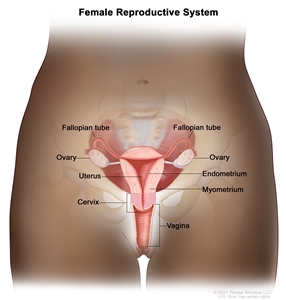
Anatomy of the female reproductive system. The organs in the female reproductive system include the uterus, ovaries, fallopian tubes, cervix, and vagina. The uterus has a muscular outer layer called the myometrium and an inner lining called the endometrium.
Several types of ovarian tumors are seen in children:
- Epithelial tumors may be benign or cancer. These tumors begin in the tissue covering the ovary. Epithelial tumors are the second most common ovarian tumor in girls. Ovarian epithelial cancer is usually found at an early stage in children and is easier to treat in children than in adults.
- Stromal tumors may be benign or cancer. These tumors begin in stromal cells, which make up tissues that surround and support the ovaries. Juvenile granulosa cell tumors and Sertoli-Leydig cell tumors are two types of stromal tumors.
- Small cell carcinoma of the ovary begins in the ovary and may spread to the abdomen, pelvis, or other parts of the body. This type of ovarian cancer is fast growing and has a poor prognosis.
- Germ cell tumors may be benign or cancer. They begin in egg cells in females and are the most common ovarian tumor in girls. Learn more about ovarian germ cell tumors at Childhood Extracranial Germ Cell Tumors Treatment.
This page is about ovarian non-germ cell tumors (epithelial tumors, stromal tumors, and small cell carcinoma of the ovary).
Ovarian tumors in children are caused by certain changes to the way ovarian cells function, especially how they grow and divide into new cells. Often, the exact cause of these cell changes is unknown. Learn more about how cancer develops at What Is Cancer?
A risk factor is anything that increases the chance of getting a disease. Not every child with a risk factor will develop an ovarian tumor. And it will develop in some children who don't have a known risk factor.
The following disorders increase a child's risk of juvenile granulosa cell tumors:
- Ollier disease is a rare disorder that causes abnormal growth of cartilage at the end of long bones.
- Maffucci syndrome is a very rare disorder that causes abnormal growth of cartilage at the end of long bones and benign blood vessel tumors in the skin.
The following disorders increase a child's risk of Sertoli-Leydig cell tumors:
- Peutz-Jeghers syndrome is a genetic disorder that causes polyps to form in the intestines and dark spots to form on the mouth and fingers.
- DICER1 syndrome is a rare genetic disorder that may cause a goiter, polyps in the colon, and tumors of the ovary, cervix, testicle, kidney, brain, eye, and lining of the lung.
Talk with your child's doctor if you think your child may be at risk.
It may not be clear from the family medical history whether your child's ovarian tumor is part of an inherited condition related to a change in the DICER1 gene. Genetic counseling can assess the likelihood that your child's cancer is inherited and whether genetic testing is needed. Genetic counselors and other specially trained health professionals can discuss your child's diagnosis and your family's medical history to help you understand:
- the options for DICER1 gene testing
- the risk of other cancers for your child
- the risk of a Sertoli-Leydig cell tumor or other cancers for your child's siblings
- the risks and benefits of learning genetic information
Genetic counselors can also help you cope with your child's genetic testing results, including how to discuss the results with family members. They can advise you about whether other members of your family should receive genetic testing.
Learn more about Genetic Testing for Inherited Cancer Risk.
Children may not have symptoms until the ovarian tumor has grown bigger. It's important to check with your child's doctor if your child has:
- pain or swelling in the abdomen
- a lump in the abdomen
- early signs of puberty
- painful or missed menstrual periods
- unusual vaginal bleeding
These symptoms may be caused by problems other than a tumor. The only way to know is to see your child's doctor.
If your child has symptoms that suggest they have an ovarian tumor, the doctor will need to find out if these are due to cancer or another problem. The doctor will ask when the symptoms started and how often your child has been having them. They will also ask about your child's personal and family medical history and do a physical exam. Depending on these results, they may recommend other tests. If your child is diagnosed with an ovarian tumor, the results of these tests will help you and your child's doctor plan treatment.
The tests and procedures used to diagnose ovarian tumors may include:
CT scan (CAT scan)
A CT scan uses a computer linked to an x-ray machine to make a series of detailed pictures of areas inside the body. The pictures are taken from different angles and are used to create 3-D views of tissues and organs. A dye may be injected into a vein or swallowed to help the tissues and organs show up more clearly. This procedure is also called computed tomography, computerized tomography, or computerized axial tomography. Learn more about Computed Tomography (CT) Scans and Cancer.
Computed tomography (CT) scan. The child lies on a table that slides through the CT scanner, which takes a series of detailed x-ray pictures of areas inside the body.
Magnetic resonance imaging (MRI)
MRI uses a magnet, radio waves, and a computer to make a series of detailed pictures of areas of the body, such as the pelvis or abdomen. This procedure is also called nuclear magnetic resonance imaging (NMRI).
Ultrasound exam
An ultrasound exam uses high-energy sound waves (ultrasound) that bounce off internal tissues or organs in the abdomen or pelvis and make echoes. The echoes form a picture of body tissues called a sonogram.
Biopsy
A biopsy is a procedure in which a sample of tissue is removed from the tumor so that a pathologist can view it under a microscope to check for signs of cancer.
Serum tumor marker test
A serum tumor marker test examines a sample of blood to measure the amounts of certain substances released into the blood by organs, tissues, or tumor cells in the body. Certain substances are linked to specific types of cancer when found in increased levels in the blood. These are called tumor markers. The tumor markers alpha-fetoprotein, beta-human chorionic gonadotropin (beta-hCG), CEA, CA-125, and others are used to diagnose ovarian cancer.
DICER1 genetic testing
DICER1 genetic testing examines a sample of blood or saliva for changes in the DICER1 gene. This test may be done for children with a Sertoli-Leydig cell tumor.
Molecular testing
A molecular test checks for certain genes, proteins, or other molecules in a sample of tissue, blood, or bone marrow. Molecular tests also check for certain changes in a gene or chromosome that may cause or affect the chance of developing an ovarian tumor. A molecular test may be used to help plan treatment, find out how well treatment is working, or make a prognosis.
The Molecular Characterization Initiative offers free molecular testing to children, adolescents, and young adults with certain types of newly diagnosed cancer. The program is offered through NCI's Childhood Cancer Data Initiative. To learn more, visit About the Molecular Characterization Initiative.
You may want to get a second opinion to confirm your child's diagnosis and treatment plan. If you seek a second opinion, you will need to get medical test results and reports from the first doctor to share with the second doctor. The second doctor will review the genetic test report, pathology report, slides, and scans. This doctor may agree with the first doctor, suggest changes to the treatment plan, or provide more information about your child's tumor.
To learn more about choosing a doctor and getting a second opinion, see Finding Cancer Care. You can contact NCI's Cancer Information Service via chat, email, or phone (both in English and Spanish) for help finding a doctor or hospital that can provide a second opinion. For questions you might want to ask at your child's appointments, see Questions to Ask Your Doctor about Cancer.
Cancer stage describes the extent of cancer in the body, such as the size of the tumor, whether it has spread, and how far it has spread from where it first formed. It is important to know the stage of ovarian cancer to plan the best treatment.
There are several staging systems for cancer. The International Federation of Gynecology and Obstetrics (FIGO) staging system is used for ovarian cancer. Based on the FIGO results, a stage is assigned to your child's ovarian cancer, such as stage I, stage II, stage III, or stage IV (may also be written as stage 1, stage 2, stage 3, or stage 4). When talking with you about your child's cancer, your child's doctor may describe it as one of these stages.
Stage I (also called stage 1) ovarian cancer
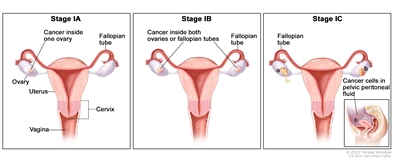
In stage IA, cancer is found inside a single ovary or fallopian tube. In stage IB, cancer is found inside both ovaries or fallopian tubes. In stage IC, cancer is found inside one or both ovaries or fallopian tubes and one of the following is true: (a) either the tumor or the capsule (outer covering) of the ovary has ruptured (broken open), or (b) cancer is also found on the surface of the ovary or fallopian tube, or (c) cancer cells are found in the pelvic peritoneal fluid.
In stage I, ovarian cancer has formed and is found in one or both ovaries or fallopian tubes. Stage I is divided into stages IA, IB, and IC.
- Stage IA: Cancer is found inside a single ovary or fallopian tube.
- Stage IB: Cancer is found inside both ovaries or fallopian tubes.
- Stage IC: Cancer is found inside one or both ovaries or fallopian tubes. Stage IC is further divided based on whether the cancer is found outside the ovary.
- Stage IC1: The tumor ruptured (broke open) during surgery.
- Stage IC2: The capsule (outer covering) of the ovary ruptured before surgery, or there is cancer on the surface of the ovary or fallopian tube.
- Stage IC3: Cancer cells are found in the fluid of the peritoneal cavity (the body cavity that contains most of the organs in the abdomen) or in washings of the peritoneum (tissue lining the peritoneal cavity).
Stage II (also called stage 2) ovarian cancer

In stage IIA, cancer is found in one or both ovaries or fallopian tubes and has spread to the uterus and/or the fallopian tubes and/or the ovaries. In stage IIB, cancer is found in one or both ovaries or fallopian tubes and has spread to organs in the peritoneal cavity, such as the colon. In primary peritoneal cancer, cancer is found in the pelvic peritoneum and has not spread there from another part of the body.
In stage II, cancer is found in one or both ovaries or fallopian tubes and has spread into other areas of the pelvis, or primary peritoneal cancer is found within the pelvis.
Stage II is subdivided based on whether the cancer has spread to other tissue.
- Stage IIA: The cancer has spread from where it first formed to the uterus and/or the fallopian tubes and/or the ovaries.
- Stage IIB: The cancer has spread from the ovary or fallopian tube to organs in the peritoneal cavity (the body cavity that contains most of the organs in the abdomen).
Stage III (also called stage 3) ovarian cancer
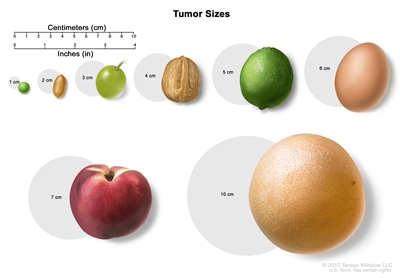
Tumor sizes are often measured in centimeters (cm) or inches. Common food items that can be used to show tumor size in cm include: a pea (1 cm), a peanut (2 cm), a grape (3 cm), a walnut (4 cm), a lime (5 cm or 2 inches), an egg (6 cm), a peach (7 cm), and a grapefruit (10 cm or 4 inches).
In stage III, cancer is found in one or both ovaries or fallopian tubes, or is primary peritoneal cancer, and has spread outside the pelvis to other parts of the abdomen and/or to nearby lymph nodes.
Stage III is subdivided based on how far the cancer has spread.
- Stage IIIA1: The cancer has spread to lymph nodes behind the peritoneum only.
- Stage IIIA2: The cancer cells that can be seen only with a microscope have spread to the surface of the peritoneum outside the pelvis, such as the omentum (a fold of the peritoneum that surrounds the stomach and other organs in the abdomen). Cancer may have spread to nearby lymph nodes.
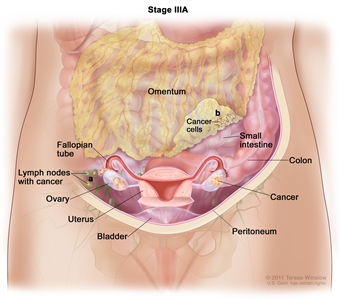
In stage IIIA, cancer is found in one or both ovaries or fallopian tubes and (a) cancer has spread to lymph nodes behind the peritoneum only, or (b) cancer cells that can be seen only with a microscope have spread to the surface of the peritoneum outside the pelvis, such as the omentum. Cancer may have also spread to nearby lymph nodes. - Stage IIIB: The cancer has spread to the peritoneum outside the pelvis, such as the omentum, and the cancer in the peritoneum is 2 centimeters or smaller. Cancer may have spread to lymph nodes behind the peritoneum.
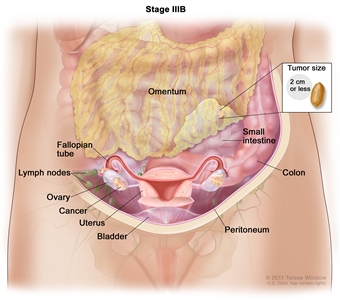
In stage IIIB, cancer is found in one or both ovaries or fallopian tubes and has spread to the peritoneum outside the pelvis, such as the omentum. The cancer in the omentum is 2 centimeters or smaller. Cancer may have also spread to lymph nodes behind the peritoneum. - Stage IIIC: The cancer has spread to the peritoneum outside the pelvis, such as the omentum, and the cancer in the peritoneum is larger than 2 centimeters. Cancer may have spread to lymph nodes behind the peritoneum or to the surface of the liver or spleen.
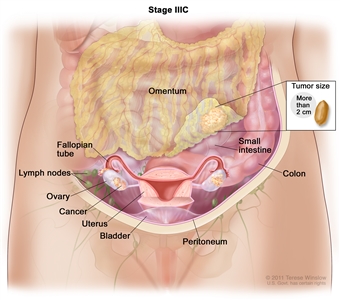
In stage IIIC, cancer is found in one or both ovaries or fallopian tubes and has spread to the peritoneum outside the pelvis, such as the omentum. The cancer in the omentum is larger than 2 centimeters. Cancer may have also spread to lymph nodes behind the peritoneum or to the surface of the liver or spleen (not shown).
Stage IV (also called stage 4) ovarian cancer
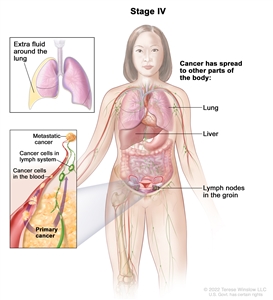
In stage IV, cancer has spread beyond the abdomen to other parts of the body. In stage IVA, cancer cells are found in extra fluid that builds up around the lungs. In stage IVB, cancer has spread to organs and tissues outside the abdomen, including the lung, liver, and lymph nodes in the groin.
In stage IV, cancer has spread beyond the abdomen to other parts of the body. Stage IV is divided into stage IVA and stage IVB.
- Stage IVA: Cancer cells are found in extra fluid that builds up around the lungs.
- Stage IVB: Cancer has spread to organs and tissues outside the abdomen, including lymph nodes in the groin.
Stage IV ovarian cancer is also called metastatic ovarian cancer. Metastatic cancer happens when cancer cells travel through the lymphatic system or blood and form tumors in other parts of the body. The metastatic tumor is the same type of cancer as the primary tumor. For example, if ovarian cancer spreads to the lung, the cancer cells in the lung are actually ovarian cancer cells. The disease is called metastatic ovarian cancer, not lung cancer. Learn more about Metastatic Cancer: When Cancer Spreads.
Recurrent ovarian cancer
Recurrent ovarian cancer is cancer that has come back after it has been treated. The cancer may come back in the ovary or as metastatic tumors in other parts of the body. Tests will be done to help determine where the cancer has returned in the body, if it has spread, and how far. The type of treatment that your child will have for recurrent ovarian cancer will depend on how far it has spread.
Learn about Recurrent Cancer: When Cancer Comes Back.
Who treats children with ovarian cancer?
A pediatric oncologist, a doctor who specializes in treating children with cancer, oversees treatment for childhood ovarian cancer. The pediatric oncologist works with other health care providers who are experts in treating children with cancer and who specialize in certain areas of medicine. Other specialists may include:
- pediatrician
- pediatric surgeon
- gynecologist
- pathologist
- pediatric nurse specialist
- rehabilitation specialist
- social worker
- psychologist
- fertility specialist
There are different types of treatment for children and adolescents with ovarian tumors. You and your child's cancer care team will work together to decide treatment. Many factors will be considered, such as your child's overall health, whether the tumor is benign or cancerous, and whether the tumor is newly diagnosed or has come back.
Your child's treatment plan will include information about the cancer, the goals of treatment, treatment options, and the possible side effects. It will be helpful to talk with your child's cancer care team before treatment begins about what to expect. For help every step of the way, see our booklet, Children with Cancer: A Guide for Parents.
The types of treatment your child might have include:
Surgery
Surgery is used to remove a tumor in the ovary. Sometimes the ovary and/or fallopian tube are also removed. During surgery to remove the tumor, fluid in the abdomen will be checked for signs of cancer.
Chemotherapy
Chemotherapy (also called chemo) uses drugs to stop the growth of cancer cells. Chemotherapy either kills the cancer cells or stops them from dividing.
Chemotherapy may be given in different ways. For ovarian cancer, chemotherapy is injected into a vein. When given this way, the drugs enter the bloodstream and can affect cancer cells throughout the body. Chemotherapy drugs used alone or in combination to treat ovarian cancer in children include:
- bleomycin
- carboplatin
- cisplatin
- cyclophosphamide
- etoposide
- ifosfamide
- vinblastine
Other chemotherapy drugs not listed here may also be used.
Learn more about how chemotherapy works, how it is given, common side effects, and more at Chemotherapy to Treat Cancer.
Stem cell transplant
High doses of chemotherapy are given to kill cancer cells. This cancer treatment destroys healthy cells, including blood-forming cells. Stem cell transplant (also called stem cell rescue) is a treatment to replace the blood-forming cells. Stem cells (immature blood cells) are removed from the blood or bone marrow of the patient and are frozen and stored. After the patient completes chemotherapy, the stored stem cells are thawed and given back to the patient through an infusion. These reinfused stem cells grow into (and restore) the body's blood cells.
Targeted therapy
Targeted therapy uses drugs or other substances to block the action of specific enzymes, proteins, or other molecules involved in the growth and spread of cancer cells.
Tazemetostat is used to treat ovarian cancer.
Learn more about Targeted Therapy to Treat Cancer.
Clinical trials
For some children, joining a clinical trial may be an option. There are different types of clinical trials for childhood cancer. For example, a treatment trial tests new treatments or new ways of using current treatments. Supportive care and palliative care trials look at ways to improve quality of life, especially for those who have side effects from cancer and its treatment.
You can use the clinical trial search to find NCI-supported cancer clinical trials accepting participants. The search allows you to filter trials based on the type of cancer, your child's age, and where the trials are being done. Clinical trials supported by other organizations can be found on the ClinicalTrials.gov website.
Learn more about clinical trials, including how to find and join one, at Clinical Trials Information for Patients and Caregivers.
Treatment of benign childhood ovarian tumors
Treatment of newly diagnosed benign ovarian tumors in children may include surgery.
Treatment of childhood ovarian epithelial cancer
Treatment of newly diagnosed ovarian epithelial cancer in children may include:
- surgery
- chemotherapy
Treatment of childhood ovarian stromal tumors
Treatment of newly diagnosed ovarian stromal tumors, including juvenile granulosa cell tumors and Sertoli-Leydig cell tumors, in children may include:
- surgery to remove one ovary and one fallopian tube for early cancer
- surgery followed by chemotherapy for advanced cancer
- chemotherapy for cancer that has recurred (come back)
Treatment of childhood small cell carcinoma of the ovary
Treatment of newly diagnosed small cell carcinoma of the ovary in children may include:
- surgery followed by chemotherapy and high-dose chemotherapy with stem cell rescue
- targeted therapy (tazemetostat)
Treatment of recurrent ovarian cancer
If the cancer comes back after treatment, your child's doctor will talk with you about what to expect and possible next steps. There might be treatment options that may shrink the cancer or control its growth. If there are no treatment options, your child can receive care to control symptoms from cancer so they can be as comfortable as possible.
Cancer treatments can cause side effects. Which side effects your child might have depends on the type of treatment they receive, the dose, and how their body reacts. Talk with your child's treatment team about which side effects to look for and ways to manage them.
To learn more about side effects that begin during treatment for cancer, visit Side Effects.
Problems from cancer treatment that begin 6 months or later after treatment and continue for months or years are called late effects. Physical problems, such as problems with fertility, are a late effect of treatment.
Some late effects may be treated or controlled. It is important to talk with your child's doctors about the possible late effects caused by some treatments. Learn more about Late Effects of Treatment for Childhood Cancer.
As your child goes through treatment, they will have follow-up tests or check-ups. Some of the tests that were done to diagnose the cancer may be repeated to see how well the treatment is working. Decisions about whether to continue, change, or stop treatment may be based on the results of these tests.
Some of the tests will continue to be done from time to time after treatment has ended. The results of these tests can show if your child's condition has changed or if the cancer has recurred (come back).
When a child has a tumor, every member of the family needs support. Taking care of yourself during this difficult time is important. Reach out to your child's treatment team and to people in your family and community for support. To learn more, see Support for Families: Childhood Cancer and the booklet Children with Cancer: A Guide for Parents.
About PDQ
Physician Data Query (PDQ) is the National Cancer Institute's (NCI's) comprehensive cancer information database. The PDQ database contains summaries of the latest published information on cancer prevention, detection, genetics, treatment, supportive care, and complementary and alternative medicine. Most summaries come in two versions. The health professional versions have detailed information written in technical language. The patient versions are written in easy-to-understand, nontechnical language. Both versions have cancer information that is accurate and up to date and most versions are also available in Spanish.
PDQ is a service of the NCI. The NCI is part of the National Institutes of Health (NIH). NIH is the federal government's center of biomedical research. The PDQ summaries are based on an independent review of the medical literature. They are not policy statements of the NCI or the NIH.
Purpose of This Summary
This PDQ cancer information summary has current information about the treatment of childhood ovarian cancer. It is meant to inform and help patients, families, and caregivers. It does not give formal guidelines or recommendations for making decisions about health care.
Reviewers and Updates
Editorial Boards write the PDQ cancer information summaries and keep them up to date. These Boards are made up of experts in cancer treatment and other specialties related to cancer. The summaries are reviewed regularly and changes are made when there is new information. The date on each summary ("Updated") is the date of the most recent change.
The information in this patient summary was taken from the health professional version, which is reviewed regularly and updated as needed, by the PDQ Pediatric Treatment Editorial Board.
Clinical Trial Information
A clinical trial is a study to answer a scientific question, such as whether one treatment is better than another. Trials are based on past studies and what has been learned in the laboratory. Each trial answers certain scientific questions in order to find new and better ways to help cancer patients. During treatment clinical trials, information is collected about the effects of a new treatment and how well it works. If a clinical trial shows that a new treatment is better than one currently being used, the new treatment may become "standard." Patients may want to think about taking part in a clinical trial. Some clinical trials are open only to patients who have not started treatment.
Clinical trials can be found online at NCI's website. For more information, call the Cancer Information Service (CIS), NCI's contact center, at 1-800-4-CANCER (1-800-422-6237).
Permission to Use This Summary
PDQ is a registered trademark. The content of PDQ documents can be used freely as text. It cannot be identified as an NCI PDQ cancer information summary unless the whole summary is shown and it is updated regularly. However, a user would be allowed to write a sentence such as "NCI's PDQ cancer information summary about breast cancer prevention states the risks in the following way: [include excerpt from the summary]."
The best way to cite this PDQ summary is:
PDQ® Pediatric Treatment Editorial Board. PDQ Childhood Ovarian Cancer. Bethesda, MD: National Cancer Institute. Updated <MM/DD/YYYY>. Available at: https://www.cancer.gov/types/ovarian/patient/child-ovarian-treatment-pdq. Accessed <MM/DD/YYYY>.
Images in this summary are used with permission of the author(s), artist, and/or publisher for use in the PDQ summaries only. If you want to use an image from a PDQ summary and you are not using the whole summary, you must get permission from the owner. It cannot be given by the National Cancer Institute. Information about using the images in this summary, along with many other images related to cancer can be found in Visuals Online. Visuals Online is a collection of more than 3,000 scientific images.
Disclaimer
The information in these summaries should not be used to make decisions about insurance reimbursement. More information on insurance coverage is available on Cancer.gov on the Managing Cancer Care page.
Contact Us
More information about contacting us or receiving help with the Cancer.gov website can be found on our Contact Us for Help page. Questions can also be submitted to Cancer.gov through the website's E-mail Us.
Last Revised: 2024-10-10
If you want to know more about cancer and how it is treated, or if you wish to know about clinical trials for your type of cancer, you can call the NCI's Cancer Information Service at 1-800-422-6237, toll free. A trained information specialist can talk with you and answer your questions.
Topic Contents
- What is childhood ovarian cancer?
- Types of childhood ovarian tumors
- Causes and risk factors for childhood ovarian cancer
- Genetic counseling for children with Sertoli-Leydig cell tumor
- Symptoms of childhood ovarian cancer
- Tests to diagnose childhood ovarian cancer
- Getting a second opinion
- Stages of childhood ovarian cancer
- Types of treatment for childhood ovarian cancer
- Side effects and late effects of treatment
- Follow-up care
- Coping with your child's cancer
- Related resources
- About This PDQ Summary
This information does not replace the advice of a doctor. Ignite Healthwise, LLC, disclaims any warranty or liability for your use of this information. Your use of this information means that you agree to the Terms of Use. Learn how we develop our content.
